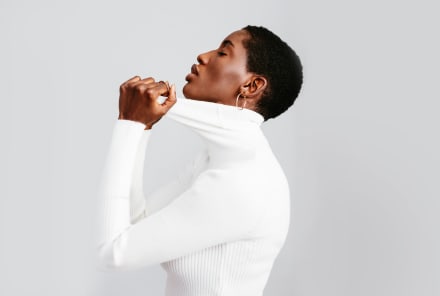Advertisement
The Medical System Was Created By Men: In 2024, Women Are Poised To Reclaim It



It’s another Monday afternoon at the mindbodygreen editorial pitch meeting. We run through our list of ideas, assign out stories, and swap research studies to set us up for successful reporting. As we dive into PubMed, the “methods” sections give us pause: A longitudinal study in a population of healthy men. A six-month study of healthy older men. Measuring blood sugar levels in men with type 2 diabetes, or obesity, or [insert health condition here]. Men, men, men.
It’s an odd, if not ridiculous, contrast, considering we are an editorial team entirely made up of women writing for readers who are mostly women. What are the subtle signs of a heart attack in women? Why do so many women feel tired all the time? How does pregnancy impact our bone health? Where is all the data on women’s bodies?
Answer: There isn’t much. But we expect that to change very soon.
Meet the experts
Stacy Sims, Ph.D.
Stacy Sims, Ph.D. is an exercise physiologist and nutrition scientist who aims to revolutionize exercise nutrition and performance for women. She has directed research programs at Stanford, AUT University, and the University of Waikato, focusing on female athlete health and performance and pushing to improve research on all women.
Abbie Smith-Ryan, Ph.D.
Abbie Smith-Ryan, Ph.D. is a professor of exercise physiology at the University of North Carolina. She is also an active researcher in the field of metabolism, sport nutrition, and exercise performance, in both healthy and clinical populations, leading projects funded by the National Institutes of Health and International and National industry sponsored clinical trials.
Women are not just small men
For years, women have been excluded from medical research, albeit for a somewhat logical reason. From 1977 to 1993, the FDA banned women of childbearing age1 from early clinical trials in part for fear of birth defects after thousands of pregnant women took the sedative thalidomide and gave birth to babies with severe limb deformities.
So, yes, this abundance of caution may have started off good-natured. Although the modernization of medicine and science happened at a time when “female hysteria2” was a common diagnosis, so one could argue the entire medical system was created to keep women out of the room.
Regardless, by seeing women as a “vulnerable” population—even women who were on contraception and not trying to get pregnant—scientists actually made them more vulnerable to various health concerns, thanks to the lack of research on women’s bodies.
Fast forward to 20143, when the NIH requires that sex be a biological variable in all studies. “You either have to include women, or you have to say why you don't include them,” says exercise physiologist and sports nutritionist Abbie Smith-Ryan, Ph.D. But these reasons can be very rudimentary.
“I was reviewing a study, and they excluded women's data because they had a menstrual cycle. That is not a valid excuse,” says exercise physiologist and nutrition scientist Stacy Sims, Ph.D., who frequently works on external ethics boards to review researchers’ scientific designs.
Still, plenty of women remain missing from other clinical trials, mainly because their changing hormone levels are thought to complicate data—and researchers typically receive a small amount of funding. “If they include women, that adds a layer of complexity, which means there’s more money involved,” Sims says.
Of course, men have hormones, too, but there’s more “normal variability” when it comes to fluctuations, Smith-Ryan tells me. Their testosterone levels wouldn’t matter as much during a study, since the range of difference is smaller and easier to predict.
Whereas if you measure a woman on day one of her cycle versus day 16, you may notice changes impacted by hormones, not necessarily by whatever outcome you’re studying. For example, let’s say you’re trying to measure the effect of blueberries on fat oxidation and lean muscle4. Because women’s biology can adapt so rapidly, it can be difficult to determine whether any positive effects come from the blueberries themselves or some other hormonal byproduct.
So, you must invest in some initial tracking to figure out a woman’s hormonal baseline before throwing another variable into the mix. “It takes more time, money, and it's difficult to get those funds to begin with,” says Smith-Ryan. “When in reality, you could just measure a man without all of that and start tomorrow.”
Even studies that do include women often miss the mark. Smith-Ryan tells me that many researchers don’t ask crucial questions such as hormonal status before tossing them into the mix.
Thanks to the aforementioned 2014 decree, a relatively higher number of women have been included in NIH-funded studies (not nearly enough, but certainly more than in the ‘90s). “But it hasn't progressed the field because we don't know anything about the women,” she says. “They've simply applied all the male protocols to females, when that's not necessarily the best approach. So it's a bit of a sloppy requirement.”
As a result, women are underrepresented in research topics that span leading causes of death in our nation (cardiovascular disease, cancer, Alzheimer’s disease, etc.), as well as more nuanced but critical health topics like building muscle (which is crucial for longevity) and movement. Oftentimes, they’re just given the same protocols as men.
Take this 2020 study, for example, that found many drugs are prescribed to women at the same dose as men, even when they gained FDA approval through pre-1993 clinical trials featuring only men.
Or consider that we still don’t have sex-specific blood pressure thresholds, despite the fact that blood pressure readings can vary for women versus men. Research states 120 mm Hg as the normal upper threshold for systolic blood pressure (SBP) in men, but women with a SBP reading of 110 mm Hg or higher (a significantly lower threshold) were at risk of developing heart disease, heart attack, and stroke.
Not to mention, symptoms for heart attack are vastly different for women (nausea, jaw pain, shortness of breath5, etc.) but the male symptoms (chest pressure, cold sweat, dizziness) are what we commonly know.
The consequences of reductionist research
This lack of research has physical and mental repercussions for women’s health. That 2020 study about drug dosing? It also found elevated blood concentrations and longer elimination times for women—as a result, women experience adverse reactions to drugs at twice the rate of men.
That lack of knowledge around women’s blood pressure margins? It leads to women experiencing elevations above that threshold but below traditional cut-offs—so they might receive a later hypertension diagnosis. Coincidentally, hypertension accounts for 1 in 5 deaths of U.S. women,6 and heart disease is the leading cause of death for women in the U.S7.
Women struggle with osteoporosis (aka, weak bones) more than men, Smith-Ryan tells me, mainly because women in the U.S. don’t get their bone density measured until their mid-60s. Whereas “a lot of women lose bone during pregnancy, postpartum, and in perimenopause,” she shares. “But we never measure that, because that's not the standard.” Men don’t typically lose bone density during midlife since they aren’t having babies, so the standard for testing happens at a later age.
“There are many things you can do to build bone over time,” Smith-Ryan adds. “Many women are taking some sort of pharmaceutical for bone, when in reality, we could have them do different exercises and nutrition younger in life.”
Women experience adverse reactions to drugs at twice the rate of men
What’s more, women have long been silenced (or labeled “crazy”) when they try to share their medical symptoms. Their pain tends to get minimized, which certainly has repercussions for their mental health.
Perhaps you’re familiar with mindbodygreen’s Invisible Illness series, in which writers share their chronic health conditions to hopefully offer solidarity to others facing similar situations. A whopping 85% of these stories come from women. And more often than not, these women discuss the mental burden of dealing with apathetic healthcare professionals.
“I remember having the thought at the age of 12 that if I told my counselor at school how depressed and anxious I was, I might be taken to a ‘crazy farm’—probably something I had heard in a movie,” writes Tegan Bukowski about her health journey. Or as Sarah Goody shares about her traumatic brain injury: “I felt very plagued by depression, because doctors couldn’t tell me exactly what was happening to me, even though I was going to the ER a few times due to overwhelming pain.”
Even women who don’t face severe health conditions can still experience these mental health repercussions—I’d say every single woman has struggled, at some point, with the societal pressure to be perfect.
“Women's bodies change very dramatically in their 40s and 50s, and it's not because they're lazy,” says Smith-Ryan. “They can follow the same diet and exercise [plan], and they can gain significant amounts of fat. Think about the mental load of that: There's lots of anxiety, depression…Their quality of life could be so much better if we could help them, but that's not ingrained in our health care system.”
The building femtech & women’s research revolution
It’s clear we need more of a push for nuanced women’s health. We’ve identified the problem—now, women are beginning to kickstart solutions.
Smith-Ryan, for one, has been a champion for the movement for ages; she currently runs a research lab that prioritizes women-specific data, such as pre-workout nutrition on metabolism8 and the mental health benefits of probiotics for female shift workers9.
First Lady Jill Biden, along with the White House Gender Policy Council, has also announced the first-ever White House Initiative on Women’s Health Research, which, within its first 45 days, will work with agencies across the federal government to recommend concrete actions to advance women’s health research.
“Every woman I know has a story about leaving her doctor’s office with more questions than answers,” the First Lady shared in a statement. “Not because our doctors are withholding information, but because there’s just not enough research yet on how to best manage and treat even common women’s health conditions. In 2023, that is unacceptable.” By calling on the scientific, private sector, and philanthropic communities, the Initiative plans to maximize investments in priority areas of focus (like heart attacks in women and menopause).
And in addition to Sims’ work on ethics boards, she offers an online course called “Women Are Not Small Men” featuring exercise and nutrition tips geared specifically to women’s bodies. She’s also currently working on a research project to find various health markers from menstrual fluid.
Watch this space
These days, more women’s health products are also actually being made with women in mind. (What a concept, right?) Take the Nella Specula, a new speculum designed by women: You may be surprised to discover that the male-designed speculum hasn’t been updated since the 1800s (despite women developing prototypes that have not been put to use). The gynecological device, with its uncomfortable angles, often makes pelvic exams painful and anxiety-inducing for women. The new Nella product has an ultra-narrow bill designed for the patient’s comfort.
Similarly, catheterization has long been known to give women UTIs10. PureWick, a new catheterization system, features a noninvasive “female external catheter” that works outside the body to effectively draw urine away. Allara, a digital platform that pairs women dealing with chronic hormonal conditions with specially trained expert doctors and registered dietitians, has also just received $10 million in funding from Google Ventures.
Back in 2022, a McKinsey report predicted we’ll see a “femtech revolution,” with an uptick in software, products, funding, and services that use technology to focus on women's health. With Sims’ menstrual testing kit (still in its early stages), plus these new medical devices and platforms made just for women, we’re certainly seeing that revolution starting.
Sims supports the rise in femtech, but she urges us to rethink the algorithms, especially when it comes to diagnostic and cycle-tracking apps. “We don't want it being driven by men with male prompt engineers. We really need it to be women working for women,” she notes.
Forecasting the future
Imagine a world in which women had been the ones to kickstart modern medicine. Their “complex” health metrics would likely already be baked into the research design—because that’s just the way things are. Women know that the way things are now—unproductive and damaging in some cases—doesn’t have to be set in stone. In 2024, we expect women-led actions to change the healthcare and research landscape. We still have a ways to go, but trust a woman with a mission to get things done.
So I leave us with a rallying call: Here's to strong women. May we know them, may we be them, may we raise them—and may we fight for their health.
10 Sources
- https://www.fda.gov/science-research/womens-health-research/gender-studies-product-development-historical-overview
- https://www.ncbi.nlm.nih.gov/pmc/articles/PMC3480686/
- https://www.ncbi.nlm.nih.gov/pmc/articles/PMC8348944/
- https://www.mdpi.com/2072-6643/15/6/1339
- https://www.heart.org/en/health-topics/heart-attack/warning-signs-of-a-heart-attack/heart-attack-symptoms-in-women
- https://www.ncbi.nlm.nih.gov/pmc/articles/PMC6005390/
- https://www.cdc.gov/healthequity/features/heartdisease/index.html
- https://pubmed.ncbi.nlm.nih.gov/30366741/
- https://pubmed.ncbi.nlm.nih.gov/30566363/
- https://www.ncbi.nlm.nih.gov/pmc/articles/PMC8992741/

















